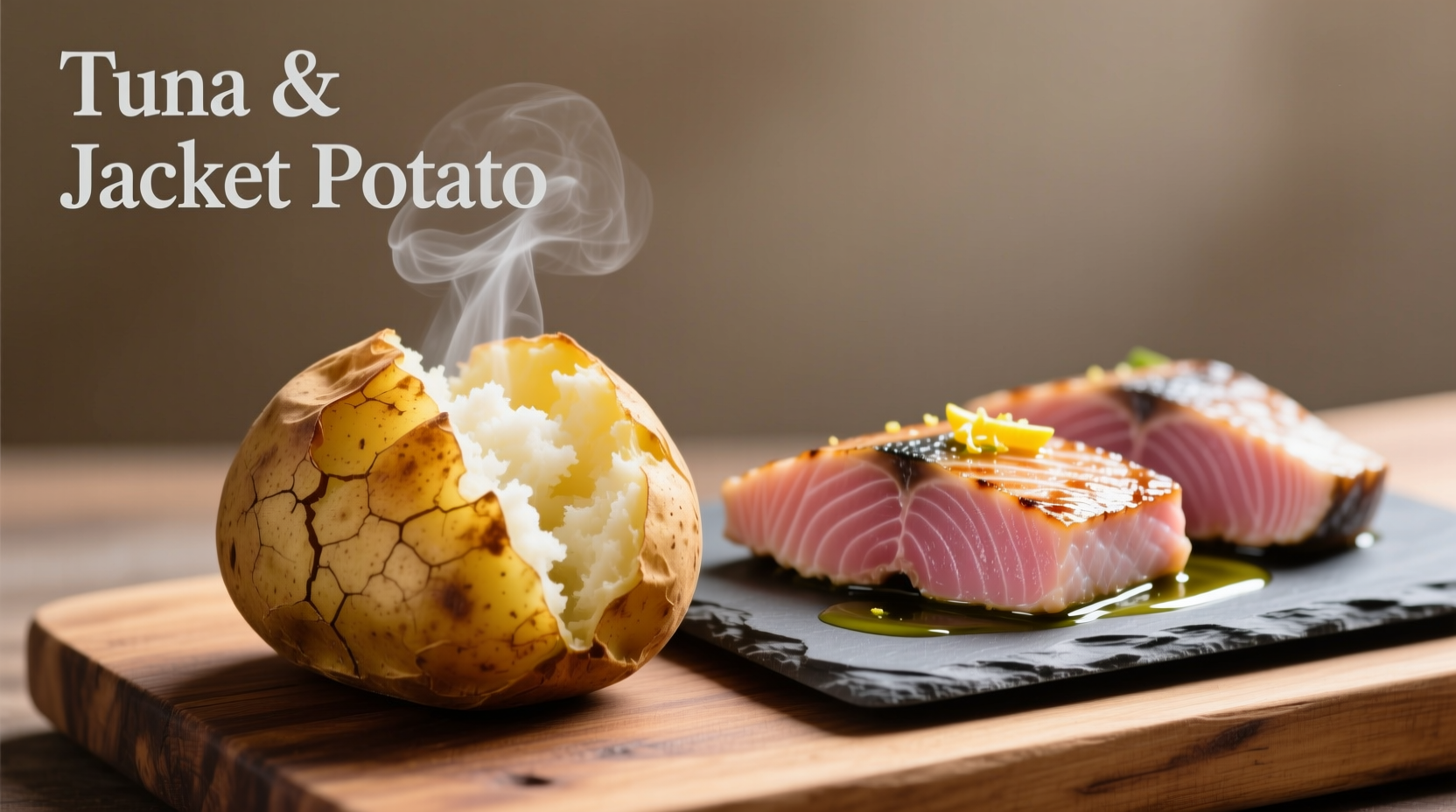Discover why this humble combination has stood the test of time as a go-to meal for students, busy professionals, and health-conscious eaters. We'll walk through the perfect technique for achieving crispy-skinned potatoes while creating a moist tuna filling that avoids the common pitfall of dryness that plagues many recipes.
Why Tuna and Jacket Potato Works So Well
The magic happens through complementary textures and balanced nutrition. The fluffy interior of a properly baked potato provides the ideal canvas for flaked tuna mixed with creamy elements. Unlike many quick meals, this combination delivers complete protein while keeping preparation time under 30 minutes when using our time-saving techniques.
| Preparation Stage | Traditional Method | Optimized Method |
|---|---|---|
| Potato Baking | 60-75 minutes | 25-30 minutes (with strategic piercing) |
| Tuna Preparation | 10-15 minutes | 5 minutes (using quality canned tuna) |
| Total Active Time | 15 minutes | 8 minutes |
Essential Ingredients Checklist
Quality ingredients make the difference between a mediocre meal and something extraordinary. For the best tuna and jacket potato experience, gather these components:
- Potatoes: Russet or Maris Piper varieties (2 medium per person)
- Tuna: 5oz (140g) canned tuna in spring water per serving
- Binding agent: 2 tbsp Greek yogurt or light mayonnaise
- Crisp elements: 2 tbsp finely diced celery and red onion
- Flavor boosters: 1 tsp Dijon mustard, lemon zest, fresh herbs
- Finishing touches: Extra virgin olive oil, flaky sea salt, cracked pepper

Step-by-Step Preparation Guide
Follow this professional technique to achieve restaurant-quality results at home. The key is managing both elements simultaneously for perfect timing.
Potato Perfection Method
- Preheat oven to 400°F (200°C) - no need to wait for full preheat
- Wash potatoes thoroughly and pierce 6-8 times with fork (critical for steam release)
- Rub skins with olive oil and coarse salt for crispy texture
- Place directly on oven rack with baking sheet below to catch drips
- Bake 25-30 minutes until fork-tender (vs traditional 60+ minutes)
Tuna Filling Technique
- While potatoes bake, drain tuna and gently press out excess liquid
- Mix with Greek yogurt (not mayo) for protein boost and less calories
- Add finely diced vegetables for crunch without overwhelming texture
- Incorporate lemon zest and fresh dill for brightness
- Season with freshly cracked pepper (avoid salt until tasting)
Nutritional Profile and Health Benefits
This meal delivers balanced nutrition that supports various dietary goals. A single serving (one medium potato with tuna filling) provides:
- Protein: 25g (excellent for muscle maintenance)
- Fiber: 6g (supports digestive health)
- Complex carbohydrates: 45g (sustained energy release)
- Healthy fats: 8g (from olive oil and tuna omega-3s)
- Key vitamins: Vitamin C, B6, potassium, and iron
According to the UK National Health Service, combining complex carbohydrates with lean protein creates a balanced meal that helps maintain stable blood sugar levels - making this an excellent choice for sustained energy throughout the afternoon or evening.
Customization Options for Every Diet
The beauty of this dish lies in its adaptability. Whether you're watching calories, following specific dietary protocols, or cooking for diverse preferences, these modifications work:
- Lower calorie: Substitute half the tuna with chopped hard-boiled egg
- Dairy-free: Use avocado instead of yogurt for creaminess
- Higher protein: Add 1 tbsp hemp seeds to the tuna mixture
- Vegetarian option: Replace tuna with seasoned chickpeas and nori flakes
- Keto adaptation: Reduce potato portion and increase healthy fats
Meal Prep and Storage Guidelines
Proper storage techniques maintain quality when preparing ahead. Follow these evidence-based recommendations from FDA food safety guidelines:
- Store components separately: potatoes and filling
- Refrigerate in airtight containers for up to 3 days
- Freeze potato halves (without filling) for up to 2 months
- Reheat potatoes in oven (not microwave) for best texture
- Always heat filling to 165°F (74°C) before serving leftovers
Avoiding Common Preparation Mistakes
Even simple recipes have pitfalls. Steer clear of these frequent errors that compromise your tuna jacket potato:
- Overbaking potatoes: Leads to dry, crumbly texture - check at 25 minutes
- Using low-quality tuna: Opt for pole-caught tuna in water for best flavor
- Skipping vegetable crunch: Celery and onion provide essential texture contrast
- Adding salt too early: Wait until after mixing to avoid drawing out moisture
- Mixing filling too vigorously: Gentle folding preserves flake structure
Ideal Contexts for This Meal
While versatile, this dish shines in specific situations. Understanding these context boundaries helps maximize satisfaction:
- Perfect for: Quick weeknight dinners, post-workout meals, budget-friendly entertaining
- Less suitable for: Formal occasions, extremely hot weather (due to oven use), strict low-carb diets without modification
- Ideal timing: Best served immediately after preparation - potatoes lose crispness when stored
- Seasonal adaptation: Add roasted vegetables in fall/winter, fresh herbs in spring/summer











 浙公网安备
33010002000092号
浙公网安备
33010002000092号 浙B2-20120091-4
浙B2-20120091-4